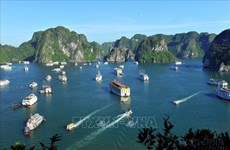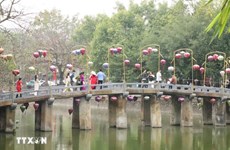Coastal Binh Dinh province expects 3.3 million tourists by 2020
The coastal central province of Binh Dinh aims to serve 3.3 million
tourists and earn 3.4 trillion VND (156.4 million USD)—accounting for
10-12 percent of its GDP—by 2020.
The coastal central province of Binh Dinh aims to serve 3.3 million
tourists and earn 3.4 trillion VND (156.4 million USD)—accounting for
10-12 percent of its GDP—by 2020.
To that end, the locality has put upgrades to its tourism infrastructure into its tourism and socio-economic development planning, and integrated tourism development with industrial and agricultural development and cultural promotion.
The upgrades include infrastructure in and roads to tourist attractions, including seaports and coastal roads, while developing Quy Nhon into a green-clean-beautiful city.
Priority is also given to attracting investments to build hotels, trade centres and entertainment venues. By 2020, the province strives to offer 180 accommodation facilities with 5,000 rooms, 35 percent of which will meet three- to five-star standards.
In the short term, Binh Dinh is calling for investments in the 400-million-USD Thi Nai lagoon eco-tourism project, the 120-million-USD Mui Rong-Tan Phung tourism site project and the five-million-USD Nui Mot lake project.
It also focuses on speeding up the implementation of the Vinpearl Quy Nhon tourism complex project worth 4 trillion VND (184 million USD), the 500-billion-VND Linh Phong pagoda project and the Thi Nai bridge tourism site.
According to Vice Chairman of the provincial People’s Committee Ngo Dong Hai, the province’s strategy to develop a tourism product system encourages investors to focus on developing coastal resort complexes like Nhon Hoi, Phuong Mai and Nui Ba, and the sea-island tourism route comprising Dua beach, Seo and Hai Au isles, Hoan Can beach and Thay Boi tower.
Binh Dinh is also working to submit a request for UNESCO recognition of its traditional martial arts as an intangible cultural heritage of humanity.
The local Bai choi singing, unique to the coastal central region and often seen at local spring festivals and resembles a game, using playing cards and village huts, has also received attention. Restoration efforts have also been focused on traditional festival and trade villages as well as historical and cultural relic sites.
According to Vice Chairman Hai, Binh Dinh targets 4,300 people working in the tourism sector—70 percent of whom receive professional training—in 2015.
It has carried out support policies for human resources training, intensified domestic and international cooperation, and accelerated communications to raise local awareness of tourism.
To that end, the locality has put upgrades to its tourism infrastructure into its tourism and socio-economic development planning, and integrated tourism development with industrial and agricultural development and cultural promotion.
The upgrades include infrastructure in and roads to tourist attractions, including seaports and coastal roads, while developing Quy Nhon into a green-clean-beautiful city.
Priority is also given to attracting investments to build hotels, trade centres and entertainment venues. By 2020, the province strives to offer 180 accommodation facilities with 5,000 rooms, 35 percent of which will meet three- to five-star standards.
In the short term, Binh Dinh is calling for investments in the 400-million-USD Thi Nai lagoon eco-tourism project, the 120-million-USD Mui Rong-Tan Phung tourism site project and the five-million-USD Nui Mot lake project.
It also focuses on speeding up the implementation of the Vinpearl Quy Nhon tourism complex project worth 4 trillion VND (184 million USD), the 500-billion-VND Linh Phong pagoda project and the Thi Nai bridge tourism site.
According to Vice Chairman of the provincial People’s Committee Ngo Dong Hai, the province’s strategy to develop a tourism product system encourages investors to focus on developing coastal resort complexes like Nhon Hoi, Phuong Mai and Nui Ba, and the sea-island tourism route comprising Dua beach, Seo and Hai Au isles, Hoan Can beach and Thay Boi tower.
Binh Dinh is also working to submit a request for UNESCO recognition of its traditional martial arts as an intangible cultural heritage of humanity.
The local Bai choi singing, unique to the coastal central region and often seen at local spring festivals and resembles a game, using playing cards and village huts, has also received attention. Restoration efforts have also been focused on traditional festival and trade villages as well as historical and cultural relic sites.
According to Vice Chairman Hai, Binh Dinh targets 4,300 people working in the tourism sector—70 percent of whom receive professional training—in 2015.
It has carried out support policies for human resources training, intensified domestic and international cooperation, and accelerated communications to raise local awareness of tourism.










